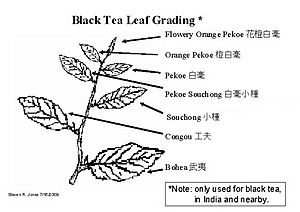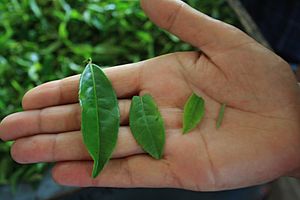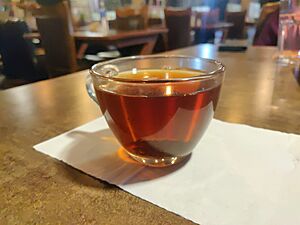Black tea facts for kids
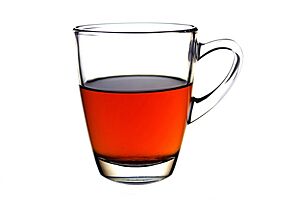
A cup of black tea
|
|
| Type | Tea |
|---|---|
| Country of origin | China |
| Region of origin | East Asia |
| Colour | Red as brewed beverage |
| Ingredients | Tea leaves |
| Related products | Tea |
| Black tea | |||||||||||||||||||||
|---|---|---|---|---|---|---|---|---|---|---|---|---|---|---|---|---|---|---|---|---|---|
| Traditional Chinese | 紅茶 | ||||||||||||||||||||
| Simplified Chinese | 红茶 | ||||||||||||||||||||
| Literal meaning | Red tea | ||||||||||||||||||||
|
|||||||||||||||||||||
Black tea is a popular type of tea. It gets its name from its dark color when brewed. In many East Asian countries, it's called "red tea" because of the reddish color of the leaves after they are processed.
Black tea is made from the leaves of the Camellia sinensis plant. It is more oxidized than other teas like green or white tea. This oxidation process gives black tea its strong, unique flavor.
Tea first came from China. Today, black tea is enjoyed and grown all over East and Southeast Asia, including in China, Japan, Korea, and Singapore.
Unlike green tea, which loses its flavor quickly, black tea stays fresh for several years. Because of this, it was once used like money in places like Mongolia and Tibet a long time ago! Black tea contains caffeine, which can help you feel more awake. It also has natural plant compounds called flavonoids.
Contents
Types of Black Tea
Unblended black teas are often named after the place they come from. Each region makes teas with special flavors.
| Region | Tea Name | Description |
|---|---|---|
| China | Lapsang souchong | This tea has a strong smoky flavor because it's dried over burning pine wood. |
| Keemun | One of China's most famous teas. It has a fruity smell, with hints of pine and flowers. | |
| Dianhong (Yunnan) | Known for its dark, malty (like malted milk) flavor and sometimes golden tea buds. | |
| Taiwan | Jinxuan (Taicha No. 12) | This tea often smells like milk and nectar. |
| Rudy Black Tea (Taicha No. 18) | It has a smell like cinnamon and a hint of mint. | |
| India | Assam | A strong, full-bodied tea with a distinct malty flavor from the lowlands of Assam. |
| Darjeeling | A lighter, floral, and fruity tea from Darjeeling. It often has a special "muscatel" (grape-like) taste. | |
| Nilgiri | A very fragrant and strong tea from the Nilgiri Hills. | |
| Sri Lanka | Ceylon | Grown at different heights, giving it different tastes. High-grown teas are light and golden, while low-grown teas are stronger and darker. |
| Turkey | Rize | This tea has a strong taste and is mahogany (reddish-brown) when brewed. It's usually served with sugar. |
Mixed Tea Flavors
Many black teas are mixed with other types of black tea. Black tea is also often blended with other plants or flavors to create new drinks.
| Blend | Description |
|---|---|
| Earl Grey tea | Black tea mixed with oil from a special fruit called bergamot. |
| Lady Grey tea | Black tea with bergamot oil, lemon peel, and orange peel. |
| English breakfast tea | A common blend of Assam, Ceylon, and Kenyan teas, often served with milk and sugar. |
| Irish breakfast tea | Mostly a blend of strong Assam teas. |
| Masala chai | This popular Indian drink mixes black tea with spices, milk, and a sweetener like sugar or honey. It's enjoyed all over India and has become popular worldwide. |
How Black Tea is Made
Making black tea involves several steps to get that rich flavor and color.
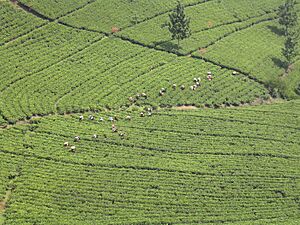
- Wilting: After tea leaves are picked, they are spread out and air is blown over them. This makes them soft and removes some water.
- Processing: The leaves are then processed in one of two main ways:
- Orthodox Method: In this method, leaves are rolled, either by hand or machine. This breaks the leaf cells and starts the oxidation process. This method often makes higher quality loose-leaf teas.
- CTC Method: CTC stands for "Crush, Tear, Curl." This method uses machines to finely chop, tear, and roll the leaves into small pellets. This is often used for tea that goes into tea bags because it brews quickly.
- Oxidation: This is a very important step! The processed leaves are left in a controlled environment with specific temperature and humidity. During this time, the natural chemicals in the leaves react with oxygen. This changes the leaves' color from green to a coppery red and develops black tea's unique flavor. This step is sometimes called "fermentation," but it's not true fermentation like in bread or yogurt.
- Drying: Once the tea has oxidized enough, it is heated to stop the oxidation process. This also removes most of the remaining water, making the tea ready to store.
- Sorting: Finally, the dried tea leaves are sorted into different sizes using sieves. This is how they get their "grades."
After these steps, the black tea is ready to be packaged and sent out to be enjoyed!
Tea Grades
Black tea is sorted into different grades based on the size of the leaves.
- Whole-leaf teas: These are the highest quality. The leaves are kept mostly whole, giving the tea a coarser texture. The best whole-leaf teas are called "orange pekoe."
- Broken leaves: These are smaller pieces of tea leaves. They are often sold as medium-grade loose teas.
- Fannings: These are small particles of tea, often left over from making larger leaf teas. They are commonly used in tea bags.
- Dusts: These are the tiniest particles of tea. They are also often used in tea bags because they brew very quickly and strongly.
Fannings and dusts have a lot of surface area, so they release their flavor into the water very fast. They usually make a darker, stronger cup of tea.
How to Brew Black Tea
Brewing a good cup of black tea is easy!
- Amount: Generally, use about 2.26 grams (about one teaspoon) of tea for every 8 ounces (about 240 ml) of water.
- Water Temperature: Unlike green teas, black tea should be steeped in very hot water, right after it boils (around 212°F or 100°C).
- Steeping Time:
- For whole-leaf black teas or teas you'll add milk or lemon to, steep for 4 to 5 minutes.
- For more delicate black teas, like Darjeeling, or for broken leaf teas (which have more surface area), steep for 3 to 4 minutes.
- Avoid Bitterness: Steeping the tea for too long can make it taste bitter.
- Serve: Once your tea has brewed long enough, strain the leaves out before drinking.
- Warm the Pot: To keep your tea hot while it brews, rinse your teapot with hot water before adding the tea leaves and hot water.
Interesting facts about black tea
- Typically, an 8-US-fluid-ounce (240 mL) cup of black tea without sweeteners or additives contains 47 mg of caffeine.
- While black tea can help you feel more alert, more research is needed to fully understand all its health effects.
- Sometimes, you might see a thin film on top of your black tea. This film is made of oxidized flavonoids and calcium from the water. It's more noticeable if you use "hard water," which has more minerals.
- Black tea contains natural compounds called flavonoids. Some scientific studies suggest that drinking black tea regularly might be good for your heart.
- Black tea consumption may be associated with a reduced risk of stroke, but more research is needed to prove it.
See also
 In Spanish: Té negro para niños
In Spanish: Té negro para niños


